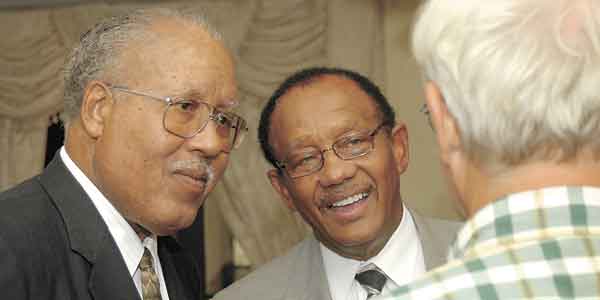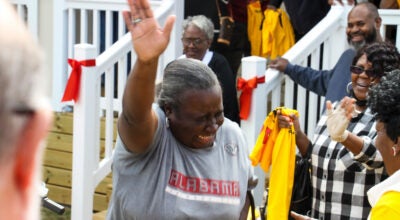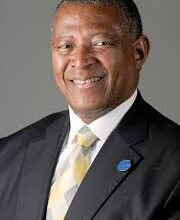ASU president talks of growth
Published 10:37 pm Monday, September 13, 2010

Alabama State University President Dr. William Harris, left, and Selma Mayor George Evans meet with Selma Rotary member Ray Thomas following Monday’s meeting at the St. James.--Tim Reeves photo
Alabama State University President William Harris remembered when someone once told him he must have been proud considering the university was Alabama’s “best kept secret.” It was at that point he knew something had to change.
Harris knew the quality of faculty teaching at the university. He knew the quality of programs offered and he knew the commitment to excellence he and his staff shared. He just needed everyone else in the state of Alabama to know it.
As part of this effort, Harris made a stop in Selma Monday to share ASU’s story and the vision the university is making become reality in Montgomery.
“People might not be surprised to learn we are now operating a $153 million budget, but they would be surprised to know that we currently have $120 million of new construction, renovations or expansion projects going on right now on campus,” Harris said. “We are changing the face of Alabama State University.”
Harris, who is in his second tenure as university president after having retired once from the school in 2000, said the school is in just part one of its overall expansion and renovation project.
In addition to the 500 new student housing units, or as Harris would call them “suites,” the university is nearly doubling its library with a 60,000-square foot addition and renovation and has also broken ground on a brand new student services center.
“It will be the center of the university once completed,” Harris said. “It will house a theater, bookstore, everything a student would need to register. It is going to be fantastic.”
But the tremendous construction, growth and restructuring of the university also provides Harris with his biggest challenge.
“It is hard for everyone to fully appreciate what is happening while all of this work is going on,” Harris said. “There are those students who are upset we tore down the student center, but we had to make room for the new one. There are those who wonder how we can run a university without a library, but we do have one. It’s just not the one we’re going to have.”
Harris also touted the improved curriculum and additional programs the university has been able to add over the past 15 years since the Knight v. Alabama case was settled in 1995.
The lawsuit, which was filed by Alabama State alumni and eventually included those from Alabama A&M, challenged the state of Alabama on the way the state funded and supported the historically black universities.
The ruling by the courts allowed a change Alabama State’s mission, which allowed the university to offer a wider range of programs and studies and put the school on a similar playing field with other state-supported universities.
The courts also challenged ASU to better diversify its student body, Harris said, making the schools offer up to $1 million a year in minority scholarships. But, that program is no longer court-mandated and is too expensive to keep going.
“When the program was going we did see the number of white students increase,” Harris said. “But we can tell a difference now that it is over.”
He said the school has seen improvement in student population diversity with the addition and expansion of its microbiology, physical therapy and robotics curriculum that is attracting a more diverse student base.
But, Harris said, those program expansions may be stymied somewhat in the face of tough economic conditions and reduction in state funding.
“I will have to say this is the toughest environment I have ever seen,” Harris said. “But, over the past two years, we have not been forced to cut any staff or teachers for economic reasons and we are very proud of that.”
He added even though the school has seen two straight years of tuition increases that the number of students has continued to climb.
“Historically when there are tough economic times people go back to school,” Harris said. “They go back to school to better their education so that they will be better prepared when the economy turns around.”
As of the last count, ASU had a student population of 5,600 with just more than 2,100 of those students living on campus. Harris believes through the school’s recruiting efforts, improved facilities and improved curriculum that the university could handle a student population close to 8,000.
In his presentation to the Selma Rotary Club, Harris made one promise to those at the meeting.
“You may not have known much about Alabama State University in the past. But, you are going to see a lot more of us here in the Black Belt,” he said. “And you’re going to be proud to say you know us.”





